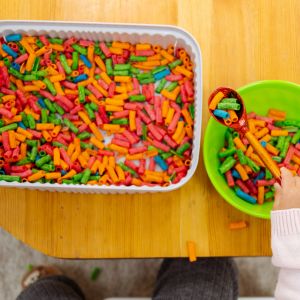
When kids play with sensory items, it helps their developing minds to build strong neural connections. This simple play set up combines sensory play with rhyming words.
Sensory play has many benefits for children’s growing minds
Sensory is a category of play that engages the five senses and encourages children to explore the world around them. These experiences, in turn, stimulate the neural networks in children’s developing brains. An article from the Cleveland Clinic explains that in addition to helping with language, fine motor (small muscle) and gross motor skills (large muscle), sensory play also helps with developing body awareness and a sense of balance while in motion. Additionally, sensory play can have a calming effect on children, which I’ve seen first hand with my kids.
Sensory play with rhyming words
Sensory play can be adapted to all kinds of learning objectives. This play set up focuses on rhyming words. It’s an excellent way to combine language learning with a sensory activity. It can be especially beneficial to children who are having difficulty learning to read, because it engages multiple senses in learning.
For this activity, you’ll need:
- a tray
- acrylic paint and brushes
- recycled cardboard
- a marker
- a sensory base, like rice, dry corn kernels, or sand
- sensory items, like pom poms, jewels, wood cut outs
- utensils


Step one: Create the rhyming words
For this sensory activity, we made use of some old food packaging as the cardboard for our rhyming hearts. You can use any kind of cardboard or card stock that you have around the house.
The first step is to cut out the shapes that you’re going to place in your sensory tray. We chose hearts, because we made this activity around Valentine’s Day. You could make any theme for your tray.
Next, paint your shapes and once they are dry, print rhyming pairs on them. Rhyming words are helpful way to learn spelling, because children can see the patterns in words. For example, if you can spell “hug” you can spell “bug”. We chose rhyming words that relate to Valentine’s Day. You could choose words to go with any theme, or simply choose from a list of word families that you’d like to work on. You could also add picture cues on the shapes to help new readers.
Step two: Create the sensory tray
Once the rhyming pairs are ready, it’s time to assemble the sensory tray. We used a plastic tray left over from a party. You can use any type of tray as long as it has a high enough edge to prevent the sensory material from spilling out. It doesn’t have to be a tray, you could also use a large box, bin or wide bowl.
Next you’ll need a sensory medium. We used orzo, which is small pasta that looks like rice. Other sensory materials you could use are: rice, ground up cereal, lentils, dried beans, dried corn kernels or sensory sand. Different mediums provide different experiences. If you like, you can even color the sensory material by using kid-safe paint or food coloring.
Finally, add some other sensory items to your tray, like pom poms, cotton balls, buttons, wood cut outs or jewels. Make sure to provide utensils and containers for scooping and pouring. Using the utensils to manipulate the materials is part of the learning experience.
Be safe with your choice of play items
Make sure to choose items that are age appropriate and developmentally appropriate for the children who will use the sensory tray. If you know that you have a child that likes to put things in their mouth, make chose taste safe items and exclude small objects that could be choking hazards. Certain mediums aren’t great choices because they can be harmful, like flour which is only meant to be eaten cooked because it can contain E. coli bacteria. So make sure to do your research on what you’re putting in your sensory play set up.



Encouraging sensory tray/bin play
Sensory play is especially effective if it’s offered as an open-ended experience for children. This allows them to engage at their own comfort level and their own pace. For the rhyming words, you could make guiding prompts, such as, “I see you found a heart that says play. I wonder if there’s a rhyming heart for play somewhere in the tray?” You could also have a paper with the corresponding matching pairs where child can place the shapes that they find with the corresponding word.
Mess will happen
Don’t be surprised if the sensory play makes a mess. It’s bound to happen. Try to avoid asking children to be tidy when they play with sensory materials, because it inhibits their willingness to explore. If you’d like to cut down on the messy aspect, you can bring sensory play outdoors where it’s easier to clean up, or put a plastic table cloth down on the floor/table to help with the clean up. Also encourage children to help tidy up as part of the experience.
Sensory play is fun beyond preschool and kindergarten
Sensory play doesn’t just have to be for young children. School age children also enjoy sensory play. I’ve included many set ups with sensory play in learning activities for school-aged children who’ve enjoyed being able to engage in hands on learning, especially when a lot of the learning moves to pencil and paper as children get older.
What are some other resources for learning rhymes?
There are lots of great word activities for teaching rhyming words. These two resources are very useful.
- 43 rhyming activities for kindergarten
- Try some of these ideas by the Kindergarten Connection
What are some other ideas for sensory play
There are so many ideas for sensory bins and trays. A lot of the items you can use are easily found at home, which means offering sensory play as an option for your children doesn’t have to be complicated or expensive. Here are some additional sensory play ideas:
- Little Bins for Little Hands has a long list of sensory play ideas
- Taming Little Monsters also has a list of 60 different sensory play ideas
If you’re interested in learning more about how children learn sounds, I recommend this article on phonological awareness.
From @365learnandplay, have fun playing together! You may also like to check out over 20 ideas for play that helps kids to learn to read.





My kids love sensory play!